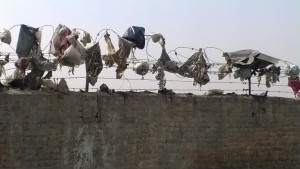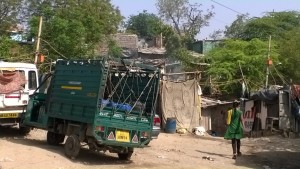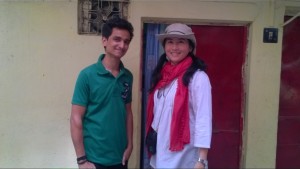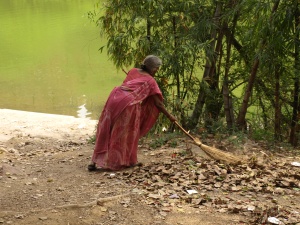One of the most difficult things for us to see and be around in New Delhi is the poverty that is everywhere. It is very hard to escape it and is something that really pulls at one’s heart. I have asked myself almost every day, “what if that were me?”. When Tyler and I visited last May before committing to the job here, we were instructed very strongly that although it would be difficult, the way to help the beggars is not to hand them money. That may seem callous, however when you understand how these children are really being used, you certainly do not want to continue their exploitation. On the other hand, when your 11 year old daughter says, “But I don’t want to have a hard heart,” one really has to question how are we going to handle the poverty here and what is best for our family to do. I want to share a little about what we have discovered so far and how we have decided to deal with the constant, daily, begging that is around us.

It is children, even at a very young age, carrying other children, that are walking through the lanes of cars on the street and tapping on windows begging for money.
Before moving here as a family, we tried to explain to our children that when we would be stopped at intersections and traffic lights, women holding babies and small children would approach our car and knock on the windows wanting money. As much as we tried to prepare our family for this part, it didn’t take very long for them realize that this was a reality that they were going to face day after day and it has been hard for them to experience. Let me explain the different types of begging one can encounter here.
- At the market: When going to a market to grab your groceries, or stop at the bank, the fact that we are “white” makes us immediate targets for the little children walking around begging. Sometimes it will be 2 or 3 young children together approaching you, sometimes it will be a teenager leading an older blind woman around holding a cup asking for you to contribute something to help her, or sometimes it is just the man with one leg or one arm sitting on the corner looking for someone to give him a few rupees.
- On the street: At nearly every street corner where there can be a long line of cars found when the traffic light is stopping traffic, one will be lucky NOT to be approached by someone. When an individual approaches your car they will just come right up to your window very close and start tapping on the window, or worse, scratching along the car, asking for money. If it is a woman holding a baby she will always use some type of hand language showing that she needs to feed her baby. (I would like to add here that most of the women carrying the babies are “renting” the babies for the day, they do not belong to them.) If they knock on your side of the car and there is no response, sometimes they move around to the other side and work the other window. There are also those individuals that are trying to sell bouquets of flowers and books or magazines as you are waiting for the traffic to take off.

Notice the small girl standing next to the auto begging for money. They move from car to car being very persistent.

This is another little girl begging at a car in front of ours.
- Tourist areas: Any area that has many tourists visit, is a spot where beggars will be found. At some religious sites that are visited by many tourists seeking to visit a famous temple or mosque, beggars will line the streets.

This is at a shrine of a Sufi saint that people from all over the world come to visit.
A few things we have discovered from our experience living here and other’s wisdom include:
- Begging is illegal. Although it is against the law to beg on the street corners, it is not enforced by the policemen and often the policemen will tolerate it as long as they get a piece of the profit.
- It is a business. There are individuals and groups that run these groups of children that are begging. Some of these children fall into this life through their parents selling them off, some are introduced to it because they have run away and are searching for a better life, some are enticed by promises that are given to them such as food, and others are just kidnapped and forced into the life. When I did the slum walk, we talked with our guide about those living in the slum versus those living on the street. He told us of one gentlemen that he got to know through conversation on the street and found out that he runs the group of children begging on a certain intersection and that is what funds his own two children that are attending universities in America.
- Children receive almost nothing. The little money that the children do bring in from their begging is handed over to the persons in charge. They are fed by these people and might get a little extra $1 for themselves in they are lucky. They are watched closely to make sure that they do not spend any of the money. They are often beaten if they are found guilty. These children on the street are getting zero education in their life because they are kept from school to go and beg for someone else.
- From personal experience, if you purchase flowers from one person on the road, or give one woman a few rupees to buy the flour she says she needs, once that money has been handed out, there will be many more beggars suddenly appearing wanting their share. The harassment does not end by helping just one person, it is the beginning.
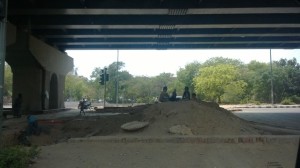
The children take breaks in the dirt at the intersections. Some even sleep right there with their little food being cooked right over a small fire made right in the dirt.
So knowing all of this and seeing it daily, how does one deal with it? Seeing the poverty and how these children in particular are living, is definitely difficult to know how to handle it and not let “your heart get hard.”. As a family we have decided that the best thing to do is to hand out some type of “child” treat to the children so that they will be able to enjoy it themselves. One day when Tyler was walking through a market, the children were following him around and asked him for even a “Kinder Joy” that he could buy at the market for them. It is a chocolate egg with a small toy inside it. So, when he came out of the market and gave them to the children, they were so happy. So, Kinder joys have become something we like to leave the house with or have a few in the car to hand out. Small packages of crackers are another thing that my driver will keep in the car and occasionally hand out. We can only hand it out if we have enough for the group of children begging, and it is best to hand it out when leaving the place because if not, you will be approached by fellow comrades of the beggar that received the Kinder egg. Not all recipients are pleased with the “food” donation. We have had some go away with a very large frown, pleading for money. My driver will say, it’s not food they want, just money.”. I believe that is a result of them needing to show up with their proceeds for the day for the man in charge.
We have also chosen as a family to increase donations that we make to our church for humanitarian purposes as well as several non profit organizations here in India. We have particularly focused on those that are using their resources wisely in furthering the education of children. For a child out begging, they have absolutely no other future ahead of them. But, if that same child is given the opportunity to obtain an education, the opportunities for the future are many as India develops.
Everyone that comes to live here from around the world has to make their own decision on the best way to care for the poor and to respond to begging. I am sure that our own perspectives will evolve over the years we live here, but for now we feel we have found an approach that is right for us.





